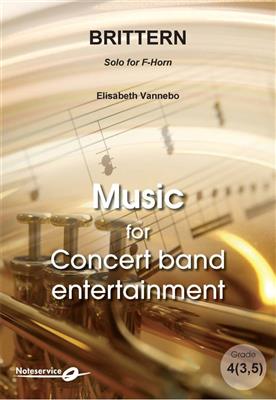Results
-
 £53.50
£53.50Down to the River
Here is an emotion-filled arrangement for young players based on the folk tune Down to the River to Pray, which is thought to have been composed by an African-American slave. There is an element of sadness in the music, but also aglimmer of hope as the slaves dream of freedom and being reunited with family and friends. Dur: 2:45
Estimated dispatch 7-14 working days
-
 £149.40
£149.40Introduction - Torstein Aagaard-Nilsen
"Introduction" is a short concert opener. I quote a couple of Norwegian Folk Tunes to make a musical picture of the Vikings running from the seashore to face a battle. They used to drink something made of mushrooms to prevent fear and pain - They became Berserkings! The piece was originally scored for Brass Band and commissioned by Manger Musikklag in 1998. This version was commissioned by The Royal Norwegian Navy Band in 2002 and re-edited in 2018.
Estimated dispatch 7-14 working days
-
 £115.60
£115.60Han Mass og han Lass
Han Mass og han Lass is a folk tune from Jlster in Norway. The arranger imagine to men sitting telling stories to each other. As the time goes, both exaggeretate more and more...... This arrangement was originally written for brass band, as a commission from the Youth Brass band of the Norwegian county of Sogn og Fjordane.
Estimated dispatch 7-14 working days
-
 £137.70
£137.70Vem kan segla frutan vind
Who can Sail without the Wind is an old folk tune from ...land in Finland. I believe the song was one of the first one I learnt to sing and play on the guitar. The melancholic character of the song is something I have brought with me ever since.
Estimated dispatch 7-14 working days
-
 £127.30
£127.30Brittern - Solo for F-Horn - Elisabeth Vannebo
"Brittern" was written for my good friend, Brit Johnsrud to her Solo-CD recording "Light Blue Outfit". Brit is a former hornist with the Stavanger Symphony Orchestra and works today with the professional Navy Band in Bergen. This solo piece is inspired by traditional, Norwegian folk music. The slurs of the music it intended to make character to the "Halling" (A traditional Norwegian dance). The music also include trills, but for these the soloist may vary and decide where to play these. The tempo are approx. quarter note=88. Chords appears at letter E in solo part. This part of the piece may be improvised. If improvised, please omit some of the parts (are marked with May beomitted).
Estimated dispatch 7-14 working days
-
 £53.50
£53.50The Legend of Billy Miner - Robert Buckley
This composition reflects a colorful time in American history and is an opportunity for your band to discover ragtime rhythms. Folk hero Billy Miner (the Grey Fox) was the last of the old-time bandits. He was noted for his unusualpoliteness and is believed to be the originator of the phrase, Hands up! This composition is like a mini movie score and starts with the Billy Miner ragtime theme, followed by a train robbery, his capture, and final release. Theartful interplay between sections gives this piece the sophisticated sound and intensity of a much more advanced work. Dur: 3:35
Estimated dispatch 7-14 working days
-
 £60.99
£60.99The Willow Tree - Pádraigín Ní Uallacháin
Although this haunting tune has the flavor and sentiment of a traditional Irish folk song, it was composed in 1995 by multifaceted artist Pdraign N Uallachin. Her inspiration for the song was the idea that when we are happy or sad, the elements and the natural world are aligned with our feelings. From the wistful lyrics of the song; Down by the river there's a tall willow tree, who weeps all night for you and me. This evocative setting for band follows this sentiment through peaks and valleys of sound and emotion. Dur: 3:10
Estimated dispatch 7-14 working days
-
 £42.50
£42.50Cumberland Gap Overture (A Wilderness Adventure) - James Curnow
Featuring mini-variations on the folk tune Cumberland Gap, this easy overture provides a musical portrait of travel through the Appalachian Mountains. Composed in a single tempo, there is still plenty of contrast in dynamics and scoring, plus fun effects. Dur: 2:20
Estimated dispatch 7-14 working days
-
 £84.99
£84.99March-Chagu-Chagu - Satoshi Yagisawa
This work was composed as ceremonial music, as part of a march medley for the participants' entry for the 71st National Sports Festival and the 16th National Disabled Personnel Sports Festival, held in Iwate Prefecture in 2016. The European premiere of this piece took place in December of that year, the composer guest conducting the Young Musicians from Fribourg, Switzerland. This work, fusing Japanese folk song with march music, will have wide appeal, like the sister work March-Bou-Shu, also published by de Haske Publications.
Estimated dispatch 7-14 working days
-
£53.95
I'm Seventeen Come Sunday - Percy Aldridge Grainger
Based on Percy Granger's choral and brass setting, this British folk song is cast for developing band by Michael Story. The delicate clarinet introduction grows in intensity with the addition of the entire woodwind family and finally the entire ensemble. Teaching opportunities are presented with introductory multi-meter. Careful attention to all articulations will guarantee a musical performance. This compelling addition to the young band repertoire allows this cherished composition to be enjoyed by a wider array of ensembles. (2:15)
Estimated dispatch 7-14 working days
